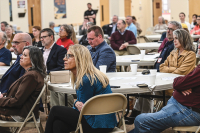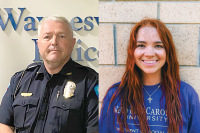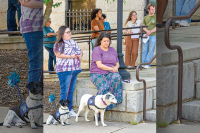Resistance to harm reduction grows in Haywood

Tensions ran high at the Aug. 3 Haywood County Board of Commissioners meeting as harm reduction critics become more vocal in their opposition and community health advocates become more frustrated over a lack of facts and understanding surrounding substance use disorder.
About 10 people spoke to commissioners during public comment regarding the county’s partnership with the North Carolina Harm Reduction Coalition, which supports a number of programs to help people experiencing homelessness and/or dealing with substance use disorder in Haywood County. Half of them were supportive of the coalition while the other half were opposed and wanted the county to end its partnership with the organization.
Jean Parris, a community advocate who started the Drugs in Our Midst education program in 2011, spoke in favor of the many harm reduction programs that have been implemented in Haywood County in the last eight years. She said she and then Waynesville Police Chief Bill Hollingsed first heard about harm reduction models in 2012 when N.C. Harm Reduction Coalition Director Robert Childs came to speak to them about the use of NARCAN, a medication that assists in stopping or reversing the effects of a drug overdose.
“Bill and I were skeptical, but his talk and his stories turned us around,” Parris said. “Immediately we said we want to do that.”
Not long after that, Waynesville Police Department became one of the first agencies to start carrying the lifesaving drug in every patrol vehicle. She said the Harm Reduction Coalition has helped supply the NARCAN at no cost to taxpayers and has also saved many lives since that time.
“We never paid a dime for NARCAN and I don’t want us to ruin that relationship. (The coalition) furnished us with syringes — we don’t want to ruin that but we do want to do a better job at keeping the numbers,” Parris said.
Related Items
Parris was speaking directly to Commissioner Mark Pless. Pless has been questioning the information the coalition provides to the county and has been demanding more data and accountability from the organization for several months. Parris told Pless it wasn’t his responsibility to take calls from people who find improperly disposed needles in the county. She reminded residents to call the proper law enforcement agency if they discover used syringes in their area. Officers are trained and have the necessary tools needed to pick up sharps and properly dispose of them. That way, Parris said, law enforcement and the Harm Reduction Coalition will have a better count of needles picked up in the county.
Peggy Hannah told commissioners she was against harm reduction measures and wanted to see the county get out of the contract agreement it has with the coalition. She said a lot of people were unhappy with the situation surrounding addiction and homelessness — problems they attribute to the coalition’s presence and work in the county.
“Is this the best we can do to help our addicts? Is there a way to make more progress instead of continuously enabling them with clean syringes instead of giving them hope to move forward?” she asked.
Kelly Kashella claimed she’s been trying to get her niece clean for 17 years, but it seems hopeless when the Harm Reduction Coalition gives her 100 clean needles.
“How many addicts are getting this type of supplies,” she said. “And they were handing out NARCAN all over Ninevah the other day… it’s to the point I can’t sit back and be quiet. My kids can’t even walk home from school at Waynesville Middle without seeing needles.”
Jesse-Lee Dunlap and Becca Goldstein — who are both harm reduction workers in Haywood — tried to provide facts about its practices and offer firsthand stories about the impact they’re having in people’s lives.
To clarify, Dunlap said the syringe program is only one piece of a much bigger harm reduction puzzle. Providing NARCAN to first responders is harm reduction, the LEAD (Law Enforcement Assisted Diversion) program adopted by Waynesville and Canton police departments is harm reduction, post overdose visits are harm reduction, providing fentanyl test strips, connecting clients with treatment is harm reduction and CIT (Crisis Intervention Team) training for law enforcement officers is harm reduction.
SEE ALSO: Harm reduction — enabling people to change their lives
Haywood County had 209 overdose reversals performed in 2019 and has already surpassed that number in 2020, Dunlap said. But the problems people are encountering in Haywood go far beyond drug use.
“I get calls about housing, food, issues with landlords, people needing rides to doctor’s appointments,” they said.
On March 31, the Balsam Center in Waynesville had to shut down its 24/7 mental health crisis center, which means many of the calls Dunlap now receives are from people experiencing a mental health crisis with nowhere to go.
They also argued that finding people a secure place to live is a barrier to getting people off the streets and into treatment.

“Seventy-nine percent of people coming out of the Haywood jail are homeless … the quickest way to put us out of a job is to put funds toward housing and mental health treatment facilities,” Dunlap said.
Goldstein shared her experience doing post overdose visits in Haywood County and invited commissioners to join her soon.
“I can’t describe to you what it’s like to see a participant access medication-assisted treatment. I can’t describe to you what it looks like when a participant has a severe mental health diagnosis and I can’t describe what it’s like to show up at someone’s house, knock on their door and talk to them after an overdose,” she said.
While some participants are more than capable of getting resources themselves, Goldstein said a visit from the Harm Reduction Coalition is often the first time they’ve received help with no judgment and no strings attached.
“I’m saying, ‘I care about you, I want you to be safe, I want you not to die,’” she said. “It takes a few times until they trust me and then I start asking about services and the trauma they’ve experienced. Then they tell you about the suffering of their friends, family and community — they are much quicker to tell you the needs of others more than themselves.”
It was through a harm reduction participant that Goldstein learned about a marginalized family that had been living without water and electricity since December. Even though no one in the household used drugs, they didn’t know how to access the help they needed.
Community health worker Kasey Valentine Steffen told commissioners she is exhausted from trying to explain these issues over and over again and trying to explain that the resources needed to make a difference just aren’t there anymore. As a Haywood County native, she said she’s fortunate to have a number of friends, families, churches and other resources to call upon if she needs help with food, paying bills, child care or anything else. However, she said, many people in the county don’t have those same privileges.
“I try to connect people to the resources I have,” she said. “Since October I’ve been trying to explain to you the resources are going down. People don’t want government involvement but I don’t see support growing anywhere else. Harm Reduction would come pick people up at midnight and take them to the Balsam Center, but now that’s closed.”
While Steffen said she would continue to seek grant funding to meet the growing needs in the community, she said she didn’t understand why Haywood County government refused to take COVID-19 relief money to put toward solving these problems.
“I’m not going to stop fighting for addicts because they have value too,” she said.
Ashley Bradley, who recently started Kaitlynne’s House in Waynesville, a halfway house for recovering mothers, agreed that the county needed to support the nonprofit programs that were working, especially if the commissioners refused to put public money toward them. People like Bradley, Dunlap, Goldstein and Steffen are the ones on the frontlines — they have been to drug houses in the middle of the night to pull someone’s loved one out and they have visited them in the hospital to let them know there’s help for them during their most vulnerable moment. However, it’s hard to help people when there is a long wait list to get into a treatment facility.
Following public comment, commissioners were given the chance to talk about harm reduction measures and the contract the county has with the coalition to provide these types of services using federal grant money the county received last year.
Commissioner Brandon Rogers said he’d been researching harm reduction programs the last few months anticipating the board would be discussing whether to extend the grant contract with HRC.
“I believe in programs that work, but if not I want to look at fixing that. I know this program was set up initially to be a good thing, but there’s red flags that have come up recently,” he said.
Commissioner Kirk Kirkpatrick said he hadn’t yet done any research on the issues but agreed that he would get input from all the stakeholders involved before a vote came before the board.
Pless said the issue had been brewing for months and that he’d like to see a more open discussion about it happen before a vote was taken. He claimed the HRC still hadn’t provided him with some informational pieces he had requested.
Commission Chairman Kevin Ensley said he did some research on harm reduction on the Centers for Disease Control and Prevention website and found that many of the claims people were making were not substantiated through the CDC’s reports. The CDC report, he said, stated HRC participants were five times more likely to enter treatment than others and three times as likely to report a reduction in drug injections, which lessens the spread of infections. The report also stated that syringe programs do not increase the number of discarded needles in public places and do not lead to higher rates of drug use and crime. Lastly, harm reduction measures are cost effective because they decrease health care costs in the long-term.
“I believe they are working in our community. Unfortunately, there’s a stigma out there and people want to say it’s the reason it’s happened. We’re blessed to have this program and Pathways and Ashley’s work with Kaitlynne’s House, The Share project, LEAD — they all work together. They are having success and saving lives,” Ensley said. “And if you think it’s a political problem, it’s a bipartisan issue. Needle exchange programs were allowed in 2016 under Gov. McCrory (Republican) with a super-Republican majority. Trump’s Health and Human Services Secretary implemented this program to reduce infections. It’s evidence based — not my opinion and not a Democrat or liberal issue. We need to base our decisions on science and not stigma.”









